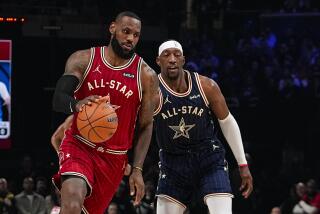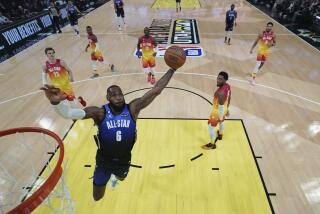Beamon Voices Concern Over High Rate of Black Homicides
- Share via
NEW YORK — It’s mid-afternoon and Bob Beamon -- full-time Olympic record-holder and part-time painter and percussionist -- peruses the front page of a New York tabloid and just shakes his head, partly out of disenchantment and partly out of disgust.
“This is a shame,” Beamon said. “This is what’s happening to black men all over the country.”
Beamon was talking about homicide.
Then, he goes into his research mode.
“I’m going to give you a statistic,” said Beamon, 47, who was a legend at Jamaica (N.Y.) High School and is a member of Adelphi University’s Hall of Fame. “A hundred thousand black males have been murdered in this country in the last 10 to 12 years.”
One hundred thousand -- or the attendance at Michigan Stadium on football Saturdays or the entire population of Green Bay, Wis.
“Now wait a minute, man,” I said to Beamon, “I knew it was high, but I didn’t think it was that high. You’re talking almost 10,000 a year.”
He said, “Yeah, that’s right.”
What does this have to do with sports? Just wait.
These chilling numbers were broken down even further by the Joint Center for Political and Economic Studies, a black think tank in Washington, D.C. Dr. John Wilson, a research associate and PhD in anthropology, education and psychology, gave out the specifics.
Statistic No. 1--About 8,000 black males are homicide victims on the average each year, mostly killed by other black males (90 percent), mostly killed by firearms (66 percent). And most of them know each other and most of the assailants have been under the influence of alcohol or some other drug (still, others die through the machismo-bravado syndrome and peer pressure).
Statistic No. 2--In 1991, of 21,500 known murders in this country, 49.6 percent of the victims were black.
Statistic No. 3--Of that 49.6 percent, 90 percent were black males, and of that 90 percent, 77 percent were between the ages of 16 and 34.
Statistic No. 4--Homicide is the leading cause of death for black males age 16 to 34. Automobile accidents are second; suicide is third.
Sixteen to 34 is the primary age range for participation in sports by black males in this country -- from high school sports to college to a double-figure career in terms of years in the pros.
This is also about perception. When black athletes such as Chris Webber (15 years, $75 million) and Larry Johnson (12 years, $84 million) sign hefty contracts, they seem to give off a signal that everything is A-OK among black males. This is during a time when many white folk, because of polarization in this country, know black males only through athletes-entertainers-TV.
You guys are making all the money. Contracts fat enough to choke a horse. But you can’t judge a book by its cover. The fact of the matter is: Things ain’t that good in some arenas.
The epidemic is also reflected by the incarcerated -- 1,097 black males in this country are on death row.
And says Beamon, “Remember, 59,000 troops died altogether in Vietnam. A hundred thousand and 59,000. For a lot of guys, they would have been better off in the war.” Furthermore, more black males are killed by other black males each year than the total number of known lynched (3,445) by the Ku Klux Klan, etc., in the past 100 years, according to a study by Tuskegee University in Alabama.
Beamon was in town recently to participate in the U.S. Olympic Committee Congress, a combination trade show and business symposium for the Olympic community. He has the longest-standing, current Olympic record in track and field, leaping 29 feet, 2 1/2 inches in the long jump Oct. 18, 1968 in Mexico City (Michael Powell broke the world record in 1991). The previous record was 27-4 3/4 inches and Beamon’s jump induced one observer to say, “When Beamon leaped, it seemed he would never come down.”
Now, Beamon is special projects coordinator for the Metro-Dade County Parks and Recreation department in Miami. And he dabbles with oil paintings -- “I’m good at abstracts,” he says -- and plays his drums.
But Beamon is also trying to paint a better life for troubled kids. In February, he will unveil his Bob Beamon Foundation, first in Florida, then hopefully regionally then nationally. As part of that, he intends to form a program called “Wind Beneath My Wings,” which is designed to assist what he calls “at-risk kids,” mainly through educational opportunities.
That’s his effort to help the disadvantaged, to help stop the fratricide, the carnage. “Athletes should be part of the role-model pie,” said Beamon, who still owns the New York state high school long jump record, set in 1965. “Just like teachers should be.”
Which is precisely the point. Help is needed from all arenas. Some of sports’ black million-dollar men should help Beamon with the educational end by, perhaps, utilizing an “Adopt-a-Class” program, as in picking a certain class grade of youngsters and paying college costs for those worthy enough of continuing on to higher education.
But what really perturbs me is when I get letters and phone calls from people all over New York essentially saying, “Leave Michael Jordan alone. Don’t criticize him for not speaking out. He brought us thrills on the basketball court. He doesn’t have to speak out on social issues. Let him be.” It’s not that simple because some of these endangered black guys living outside the lines need constructive aid from anyone who can give it, and that includes Michael Jordan.
An athlete can have a positive impact on a young person’s life. All you have to do is read the story package on Bob Lanier, an NBA Hall of Famer, in the Nov. 3 issue of USA Today to understand that. His caring worked wonders in Florida, changing a world-class truant into a full-time student.
But, we, including help groups, must also come to grips with the chaos perpetuated and many leaders -- black and white -- must end this state of denial they appear to harbor. The NAACP, for example, seems more interested in whether Charlotte, N.C., would receive an NFL expansion franchise than the social ills plaguing its constituency. Furthermore, we, especially black folk, must learn to discuss this problem of intraracial extermination in an open and rational manner.
Which takes us to Stat No. 5. In May, 1992, Colts defensive end Shane Curry, 24, was shot and killed by a 15-year-old black kid. The quarrel reportedly started over a parking space at a Cincinnati nightclub.
And Statistic No. 6. Albert LaShon Preston, 18, who would have been a starting tight end as a senior for Anacostia High School in southeast Washington, D.C., was shot twice in the chest and killed by another black 18-year-old the night before a football game in September.
The statistics don’t lie: For every group of Chris Webbers eyeing a $75-million check, there’s another group of 10,000 eyeing the cemetery. That’s a reality check.
More to Read
Go beyond the scoreboard
Get the latest on L.A.'s teams in the daily Sports Report newsletter.
You may occasionally receive promotional content from the Los Angeles Times.







